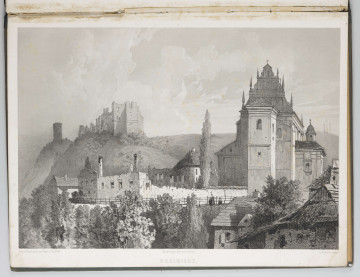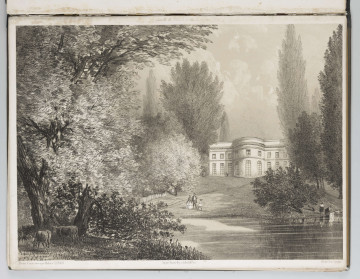
Kazimierz
1860
National Museum in Lublin
Part of the collection: Lubliniana. Painting views of Lublin and the Lublin Region
The former palace chapel of the Czartoryski family dedicated to Assumption of the Mother of God (church ‘on the hill’, since 1919 the parish Church of the Assumption of the Blessed Virgin Mary), erected in the years 1800-1803 on the edge of a hill leaning towards the Vistula, at the former Lublin road, is one of the most important projects of the Czartoryski princes and the architect Christian Piotr Aigner working for them. This classicist central building, in the form of a rotunda, with a Corinthian six-column portico, is modelled on the Roman Pantheon. Next to it, there is a bell tower dating back to 1830.
The view also shows the crowded market scene at the foot of the hill. The place for the market square in Puławy was designated in the Czartoryski times, in 1811, by the grandson of August III Wettin, Frederick August I, elector and then king of Saxony (1736-1827), who in the years 1807-1815 was ruling the office of the Duke of Warsaw as Frederick August III as a result of the personal union between the Duchy of Warsaw and Saxony. He granted Puławy the right to hold ten fairs a year. The establishment of the market square enabled the development of the town in this area. The Piaski district stretched just beyond the Lublin route, paved partially by the Czartoryski family. The houses of courtiers and craftsmen concentrated in the palace settlement gave Puławy a small-town character. Independently, south of the ducal residence, there was the old village of Włostowice with a parish church funded by Elżbieta née Lubomirska, Sieniawska, the great-grandmother of Prince Adam Jerzy. Also in 1811, Puławy was connected with Końskowola – the center of the Końskowola estate belonging to the Czartoryski family – with the first solid road in the Lublin region, which also favoured the development of the town in the times of Adam Jerzy.
The tradition of fairs goes back to medieval Poland. It was a place for all kinds of trade and an opportunity for social meetings. In the vicinity, large fairs in Wąwolnica, Kazimierz Dolny and Końskowola had been operating for a long time. Those fairs function to this day, as does the one in Puławy.
Renata Bartnik
Author / creator
Dimensions
cały obiekt: height: 43,7 cm, width: 32,5 cm
Object type
graphics
Technique
lithography
Material
paper
Creation time / dating
Creation / finding place
Owner
The National Museum in Lublin
Identification number
Location / status

1860
National Museum in Lublin

1860
National Museum in Lublin

1860
National Museum in Lublin
DISCOVER this TOPIC
Castle Museum in Łańcut
DISCOVER this PATH
Educational path